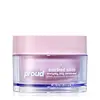What's inside
What's inside
 Key Ingredients
Key Ingredients

 Benefits
Benefits

 Concerns
Concerns

 Ingredients Side-by-side
Ingredients Side-by-side

Water
Skin ConditioningGlycerin
HumectantButylene Glycol
HumectantCetyl Ethylhexanoate
EmollientCoco-Caprylate/Caprate
EmollientSea Water
HumectantSqualane
EmollientUndecane
EmollientC14-22 Alcohols
Emulsion StabilisingButyrospermum Parkii Butter
Skin ConditioningAloe Barbadensis Leaf Juice
Skin ConditioningHydrogenated Lecithin
EmulsifyingTridecane
PerfumingHydroxyacetophenone
AntioxidantPanthenol
Skin ConditioningTocopheryl Acetate
AntioxidantXylitylglucoside
HumectantAnhydroxylitol
Humectant1,2-Hexanediol
Skin ConditioningC12-20 Alkyl Glucoside
EmulsifyingCarbomer
Emulsion StabilisingAllantoin
Skin ConditioningXanthan Gum
EmulsifyingXylitol
HumectantParfum
MaskingMacadamia Ternifolia Seed Oil
EmollientAminomethyl Propanol
BufferingSodium Hyaluronate
HumectantDisodium EDTA
Citric Acid
BufferingBenzyl Alcohol
PerfumingCurcuma Longa Root Extract
MaskingPotassium Sorbate
PreservativeCentella Asiatica Extract
CleansingCucurbita Pepo Seed Extract
Skin ConditioningSodium Benzoate
MaskingAmyris Balsamifera Oil Acetylated 100%
PerfumingElettaria Cardamomum Seed Oil
MaskingJuniperus Virginiana Oil
MaskingSalvia Sclarea Oil
MaskingEucalyptus Globulus Leaf Oil
PerfumingBoswellia Carterii Gum Extract
PerfumingCamphor
MaskingCinnamomum Camphora Linalooliferum Wood Oil
PerfumingCitrus Aurantium Dulcis Oil
MaskingPogostemon Cablin Leaf Oil
MaskingCitrus Sinensis Peel Oil Expressed
PerfumingCananga Odorata Flower Oil
MaskingLinalool
PerfumingLimonene
PerfumingGeraniol
PerfumingWater, Glycerin, Butylene Glycol, Cetyl Ethylhexanoate, Coco-Caprylate/Caprate, Sea Water, Squalane, Undecane, C14-22 Alcohols, Butyrospermum Parkii Butter, Aloe Barbadensis Leaf Juice, Hydrogenated Lecithin, Tridecane, Hydroxyacetophenone, Panthenol, Tocopheryl Acetate, Xylitylglucoside, Anhydroxylitol, 1,2-Hexanediol, C12-20 Alkyl Glucoside, Carbomer, Allantoin, Xanthan Gum, Xylitol, Parfum, Macadamia Ternifolia Seed Oil, Aminomethyl Propanol, Sodium Hyaluronate, Disodium EDTA, Citric Acid, Benzyl Alcohol, Curcuma Longa Root Extract, Potassium Sorbate, Centella Asiatica Extract, Cucurbita Pepo Seed Extract, Sodium Benzoate, Amyris Balsamifera Oil Acetylated 100%, Elettaria Cardamomum Seed Oil, Juniperus Virginiana Oil, Salvia Sclarea Oil, Eucalyptus Globulus Leaf Oil, Boswellia Carterii Gum Extract, Camphor, Cinnamomum Camphora Linalooliferum Wood Oil, Citrus Aurantium Dulcis Oil, Pogostemon Cablin Leaf Oil, Citrus Sinensis Peel Oil Expressed, Cananga Odorata Flower Oil, Linalool, Limonene, Geraniol
Water
Skin ConditioningGlycerin
HumectantCyclopentasiloxane
EmollientButylene Glycol
HumectantDimethicone
EmollientSodium Chloride
MaskingDimethicone Crosspolymer
Emulsion StabilisingPhenoxyethanol
PreservativePEG/PPG-18/18 Dimethicone
EmulsifyingCetyl PEG/PPG-10/1 Dimethicone
EmulsifyingChlorphenesin
AntimicrobialRosa Damascena Flower Water
MaskingParfum
MaskingPentylene Glycol
Skin ConditioningBiosaccharide Gum-1
HumectantSodium Acetylated Hyaluronate
HumectantSodium Hyaluronate
HumectantSodium Hyaluronate Crosspolymer
HumectantHydrolyzed Sodium Hyaluronate
Skin ConditioningEthylhexylglycerin
Skin ConditioningBenzyl Salicylate
PerfumingCI 14700
Cosmetic ColorantWater, Glycerin, Cyclopentasiloxane, Butylene Glycol, Dimethicone, Sodium Chloride, Dimethicone Crosspolymer, Phenoxyethanol, PEG/PPG-18/18 Dimethicone, Cetyl PEG/PPG-10/1 Dimethicone, Chlorphenesin, Rosa Damascena Flower Water, Parfum, Pentylene Glycol, Biosaccharide Gum-1, Sodium Acetylated Hyaluronate, Sodium Hyaluronate, Sodium Hyaluronate Crosspolymer, Hydrolyzed Sodium Hyaluronate, Ethylhexylglycerin, Benzyl Salicylate, CI 14700
 Reviews
Reviews

Ingredients Explained
These ingredients are found in both products.
Ingredients higher up in an ingredient list are typically present in a larger amount.
Butylene Glycol (or BG) is used within cosmetic products for a few different reasons:
Overall, Butylene Glycol is a safe and well-rounded ingredient that works well with other ingredients.
Though this ingredient works well with most skin types, some people with sensitive skin may experience a reaction such as allergic rashes, closed comedones, or itchiness.
Learn more about Butylene GlycolGlycerin is already naturally found in your skin. It helps moisturize and protect your skin.
A study from 2016 found glycerin to be more effective as a humectant than AHAs and hyaluronic acid.
As a humectant, it helps the skin stay hydrated by pulling moisture to your skin. The low molecular weight of glycerin allows it to pull moisture into the deeper layers of your skin.
Hydrated skin improves your skin barrier; Your skin barrier helps protect against irritants and bacteria.
Glycerin has also been found to have antimicrobial and antiviral properties. Due to these properties, glycerin is often used in wound and burn treatments.
In cosmetics, glycerin is usually derived from plants such as soybean or palm. However, it can also be sourced from animals, such as tallow or animal fat.
This ingredient is organic, colorless, odorless, and non-toxic.
Glycerin is the name for this ingredient in American English. British English uses Glycerol/Glycerine.
Learn more about GlycerinParfum is a catch-all term for an ingredient or more that is used to give a scent to products.
Also called "fragrance", this ingredient can be a blend of hundreds of chemicals or plant oils. This means every product with "fragrance" or "parfum" in the ingredients list is a different mixture.
For instance, Habanolide is a proprietary trade name for a specific aroma chemical. When used as a fragrance ingredient in cosmetics, most aroma chemicals fall under the broad labeling category of “FRAGRANCE” or “PARFUM” according to EU and US regulations.
The term 'parfum' or 'fragrance' is not regulated in many countries. In many cases, it is up to the brand to define this term.
For instance, many brands choose to label themselves as "fragrance-free" because they are not using synthetic fragrances. However, their products may still contain ingredients such as essential oils that are considered a fragrance by INCI standards.
One example is Calendula flower extract. Calendula is an essential oil that still imparts a scent or 'fragrance'.
Depending on the blend, the ingredients in the mixture can cause allergies and sensitivities on the skin. Some ingredients that are known EU allergens include linalool and citronellol.
Parfum can also be used to mask or cover an unpleasant scent.
The bottom line is: not all fragrances/parfum/ingredients are created equally. If you are worried about fragrances, we recommend taking a closer look at an ingredient. And of course, we always recommend speaking with a professional.
Learn more about ParfumSodium Hyaluronate is hyaluronic acid's salt form. It is commonly derived from the sodium salt of hyaluronic acid.
Like hyaluronic acid, it is great at holding water and acts as a humectant. This makes it a great skin hydrating ingredient.
Sodium Hyaluronate is naturally occurring in our bodies and is mostly found in eye fluid and joints.
These are some other common types of Hyaluronic Acid:
Learn more about Sodium HyaluronateWater. It's the most common cosmetic ingredient of all. You'll usually see it at the top of ingredient lists, meaning that it makes up the largest part of the product.
So why is it so popular? Water most often acts as a solvent - this means that it helps dissolve other ingredients into the formulation.
You'll also recognize water as that liquid we all need to stay alive. If you see this, drink a glass of water. Stay hydrated!
Learn more about Water